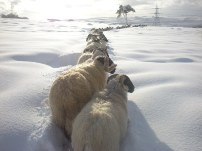News Review 2010: A year of weather extremes

Farmers Weekly highlights some of the key events that shaped 2010. Here we talk about the extremes of weather we’ve all experienced over the past 12 months.
Farmers may or may not believe in climate change, but 2010 started and ended with severe weather – and there were some very unseasonal periods in between.
Most farms were under snow at the turn of the year – and for the worst affected, it lasted well into January. Weeks of low temperatures meant regular snow falls kept winter grass further and further away from the mouths of sheep flocks still outside.
Spring was early in many areas, but although snow remained on high ground, the “melt” left behind surprisingly little moisture. Drought was soon a nationwide topic and even the northern hills that had been covered in snow for so long were as bare as many farmers could ever remember by May.
Some areas enjoyed a “normal” summer – if there can now be such a thing – but for others it was dismal. The north suffered weeks of continual rain during June, July and August, which did little to help farmers replenish empty hay barns and silage pits. An improvement by early autumn brought a surge of grass growth in many parts.
But no-one expected that by mid-November – with tups barely turned out in many hill flocks – the UK would once again be plunged into arctic conditions. The end of 2010 saw daytime temperatures hit all-time lows in many regions, and once again put sheep producers’ fodder supplies under great pressure.
The 2010 weather proved that climatic patterns and traditional seasons can longer be relied upon. Weeks of sub-zero temperatures are a new experience for the UK, but for them to have arrived so suddenly, so early and to have fallen so deeply and be sustained for so long, are worrying aspects of a year that made talking about the weather far more than a mere pleasantry of conversation.
